VETERAN and FAMILY DEPLOYMENT SUPPORT:
The Horse is a Mirror reflecting Service Members and Family Dynamics
EAGALA Conference March 2015 Boje & Rosile EAGALA military veterans Presentation slikde
Presentation to the MILITARY AND VETERAN'S AFFAIRS COMMITTEE of NEW MEXICO, September 22, 2014
David M. Boje, Ph.D. and Grace Ann Rosile, Ph.D. New Mexico State University
Our objective as an interdisciplinary team of New Mexico State University and Texas Tech University 'researchers' is to do Random-Control-Trials (RCT's) that assess the relative and combined efficacy of two innovative training systems that can be applied in the clinical facilities of the Military Health System
Our story is we do not have a ranch in Southern New Mexico where we can do deployment support for Veterans and Family members. We are veterans helping veterans. This money will allow us to get a ranch in Cloudcroft New Mexico. It will be dual purpose - More see LEGACY RANCH PROGRAM
Horses find new life off the track healing veterans
- 1 year ago
- 72,839 views
1. Help veterans and family members when they reunite post-deployment
2. Work with homeless veterans and homeless in tranitional housing, to provide training in ranch life, working with animals, learning skills to develop their own entrepreneurial ventures ventures.
Veterans and families need a place to DECOMPRESS, to get in tune with Nature. Equine-assisted work I pioneer in restorying does just that Veterans Theater work in restorying
NMSU Professor Helps Veterans Share Their Story And Move Forward
Read KRWG story online; YouTube Link address
-
Fronteras 430: Helping out Veterans - Dr. David Boje
Fronteras: A Changing America Anthony Moreno interviews Dr. David Boje, an NMSU Business Professor who is a Vietnam ...
We seek a letter of support to apply for federal funding sources (DoD and NIH). This will expand the impact of our Pilot Study. In our Pilot Study (Boje, Rosile, Hacker, EnglandKennedy, & Flora, 2013), we perfected ‘Embodied Restorying Process’ (ERP) (Rosile, 2007; Rosile & Boje, 2002) in four trials, with control group, on a very limited sample of six families into two treatment condtions, and six families in control (no treatment) condition (placed on waiting list for additional funding to do next available trials). We use two treatment processes to help veterans and their families transition to civilian life after deployment.
- Equine Assisted Growth Learning Events (EAGLE). David Boje, Ph.D. and Grace Ann Rosile, Ph.D. are certified equine-specialists with EAGALA, and certified to work with veterans and family members. The horse mirrors the disposition of Service Member and their Family members. We consider the Equine-arena to be like a large sand tray, in which a herd of blood-and-flesh people encounter a herd of blood-and-flesh horses.
- Embodied Restorying Process (ERP) and original approach using sandplay objects that veterans and their families assemble to depict a visual story of deployment to a combat theatre and return to family life. In Restorying sessions we use plastic and cotton figures in a 2 ft. by 2.5 ft. sand tray, instead of traditional text/talk restorying.
SLIDE SHOW for this PRESENTATION
Our Pilot Study is with Student Veterans, and their family members is based in EGALA. Our hope is to obtain additional funding to work with active military Service Members, and use Random Control Trials reasearch design on a larger sample that will allow for reliable data. We use EGALA procedures. We are certified to do research and work as aEGALA Military Services Provider
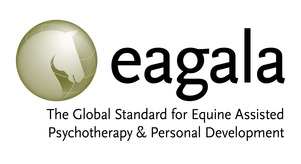 David Boje & Grace Ann Rosile are certified with EGALA
David Boje & Grace Ann Rosile are certified with EGALAOur New Mexico State University pilot-study was funded by an Interdisciplinary Grant through the Vice President of Research's office. It is Random Control Trials (RCTs) research design, with 6 student veterans and family members, on four trials of equine-assisted learning tasks and 3 of these get Embodied Restorying Process (ERP) in combination with equine-assisted learning. Here is our outreach information:

Our research addresses four severe problems that veterans and their family members face with deployment, and return to civilian life.
Background to the problem areas
First severe problem: suicides among veterans. Our research concerns interventions that reduce the risk of suicide. Veterans enrolled with Veterans Health Admin decreased by 30%, but non-enrolled soared by 60%.
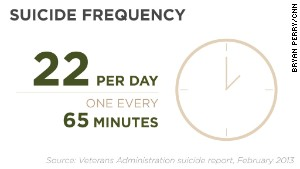
Do the math: 22 suicides a day; 8030 a year, 56,210 every 7 years.
This is a severe problem, because in 2012, the number of suicides began to exceed the number of deaths in combat. This had never happened before in the history of U.S. military service.
How a Marine Unit’s High Suicide Rate Got That Way - The New York Times
Since coming back from Afghanistan in 2008, the hard-hit Second Battalion, Seventh Marine Regiment has struggled to adjust. The battalion, known as the 2/7, lost 20 men in war. In the years since, it has lost 13 more to suicide. The battalion now has a suicide rate 14 times that for all Americans.
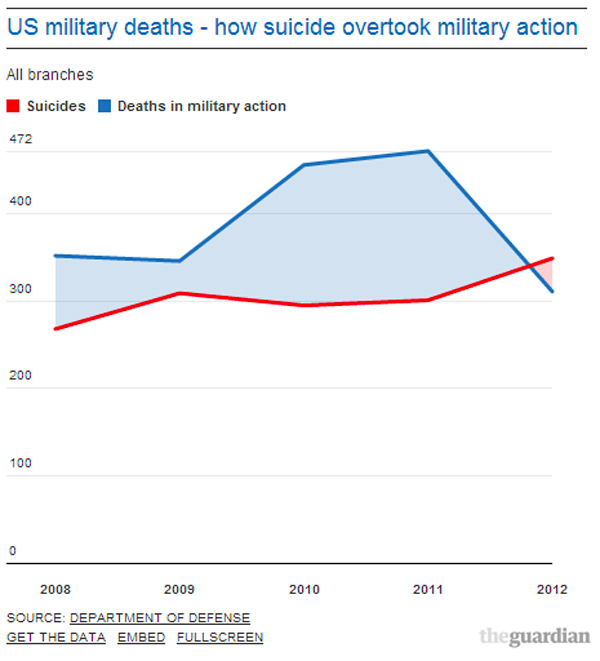
The suicide problem is highest in SouthWest United States.

A second severe problem, is that many veterans are not using VHA services.
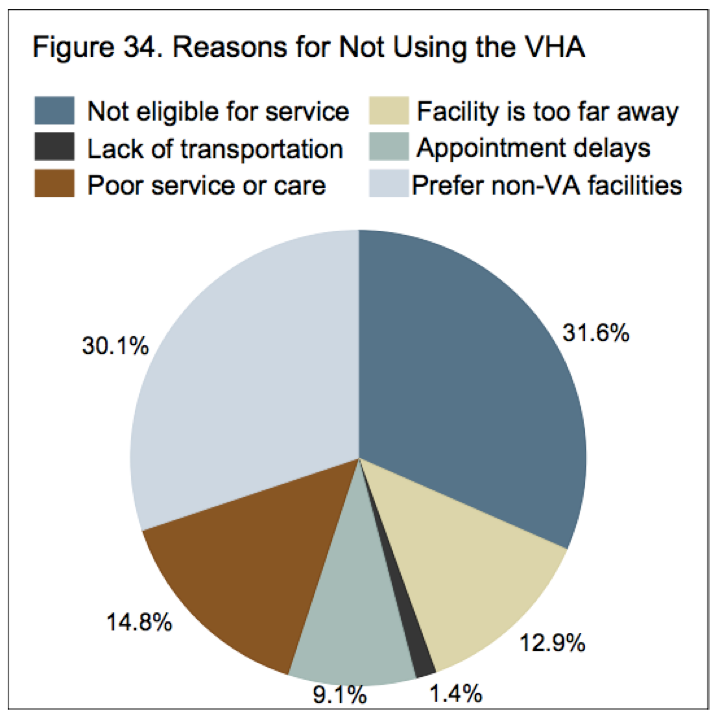
The VA has a backlog of 900,000 unprocessed medical claims (More).
There is a problem that Post-Traumatic Stress Disorder (PTSD) and Military Sexual Trauma (MST) is being under-counted. One reason is some commanders instruct soldiers returning on the plane or ship to the states, to fake the PTSD test. "
The military's war on stigma
"Fearing for their careers, many service members keep quiet about their mental health problems—and their silent suffering is taking a toll on our military readiness"... "Why the secrecy? Many service members fear that seeing a psychologist will sink their careers, says Navy Cmdr. Anthony Arita, PhD. They worry—often needlessly—that their problems will get back to their bosses, endanger their security clearances and even result in their separation from the service, he notes." (More from American Psychological Association).
Third severe problem. The family often pays a price for Service Member's deployment.

Since reaching a high of 8 percent in 2011, the female divorce rate has gone down -- hitting 7.9 percent last year and 7.2 percent this year. Female military members consistently have a much higher rate of divorce than their male counterparts across all services. The rate among males -- 2.9 percent in 2013 More
Fourth severe problem: female service members experiencing Military Sexual Trauma (MST), a very under-researched area. PTSD (DSM-V) is reported in female service members with MST. "Over the past five years, the topics of PTSD and MST have dominated the mental health literature about women veterans’ psychologies. Research provides growing evidence that women suffer PTSD at greater rates than men do. However, much of this PTSD is initially unrecognized by providers" (Blanton and Foster, 2012: 5)

The greated the length of service, the higher the odds that MST will happen.

Female Service Members are more likely that males, to experience MST with consequences for higher risk of PTSD, Depression, Anxiety, Sleep Disorder, and/or Substance Abuse.
Source: Blanton, Rebecca E., and Lisa K. Foster. (2012). California's Women Veterans: Responses to the 2011 Survey. CRB 12-004. California Research Bureau. 900 N Street Suite 300, PO Box 942837, Sacramento, CA 94237-0001. More.
See also Armed Services Study Report of Sexual Trauma and PTSD, 2014
OUR INTERVENTIONS AND RESEARCH
Boje, D. M.; Rosile, G. A.; Hacker, K. L.; England Kennedy, E. S.; Flora, J. (2013). Combining Restorying and Equine-assisted skills training in counselor communication designed to help soldiers and their families recover from traumatic stress.
We are researchers. Our objective is to use Random Control Trials (RCTs) to test the efficacy of two widely used interventions. So far, neither approach has been subjected to random assignment of subjects to treatment and control conditions, and there have not been more than one trial or the follow-up after several months to see the long-lasting effects of intervention treatments. Our Interdisciplinary grant was approved for funding by NMSU Office for Research. However, it is under-financed, and only allows us ennough resources to work with six Service Members and Family Members in two treatment conditions, and six more families are assigned to the control group (on wait-list for additional funding). This combination of two treatments, in comparison to control condition (no treatment) will let us research the more or less efficacious outcomes. We hypothesize that both Equine-Assisted Growth Learning Events (EAGLE) and Embodied Restorying Process (ERP) will have measurable efficacy outcomes (performance resiliancy, persistence, outcome expectance that tasks can be done, and motivation).

Figure 1: Efficacy Outcomes of doing Equine-Assisted Growth Learning Events (EAGLE) Embodied Restorying Process (ERP)
We are also doing pre- and post test surveys of PTSD, family well-belling, and so on. Pluse we use interviews and observation protocols to investigate what is happening during these interventions that would explain the efficacy outcomes. Our theory: The Equine-Assisted (EAGLE) Skills Training builds 'Mastery Experience' and with the Family Members, the 'Vicarious Narrative Experiences' that change (t-1 Affective States). In doing the Embodied Restorying Process' there are changes in 'Social Persuasion' by developing 'Living Stroy Webs' in the in the steps of Restorying, when done with a ♥-of-Care.
Why Storytelling: Its about Story Listening
From Storytelling to Storylistening: John Maeda (Future of StoryTelling 2014)
It is time for military leaders and the Military Medical System to do story listening. One way to do this is to work with Embodied Restorying Process (ERP). Unlike traditional 'restorying' that is text-based (talk-based), ERP focuses on letting Service Members and Family members to do a non-verbal layout of thier deployment experience using material objects, during sandplay. Unlike traditional sandplay, which used Jungian or Freudian interpretation schemes by the psychologist or psychoanalyst, ERP is focused on encouraging the Service Member and Family members to tell thier own story, while the counselors do Story Listening.
This is work using the 'Embodied Restorying Processes' and new 'sandplay' methods was originally done to help formerly homeless veterans develop a more efficacious set of outcomes (performance, persistence, outcome expectancy, and motivation) antenarratives.The work was done at Community of Hope by David Boje and Liz EnglandKennedy, and has Internal Review Board approval for the project. Antenarrative is a concept developed by David Boje, to help storytellers make better 'bets on the future' (Boje, 2001, 2011). With the ERP, the veterans develop new 'bets on their future.' Each round of restorying is hypothesized to improve self-efficacy, empowerment, and self-agency. The veteran learns to restory their past-experiences in ways that take them out of the victim-role and into the self-agency role, resulting in developing more possible, and positive futures.
Boje, D.M. (2001). Narrative Methods for Organizational and Communication Research. London: Sage.
Boje, D. M. (2011). The Future of Storytelling in Organizations: An Antenarrative Handbook. London: Routledge.
The Embodied Restorying Process (ERP) begins with recharacterize, so the problem becomes the problem, not the person (Rosile, 2007; Rosile & Boje, 2002). We became interested in adapting ERP to the field of 'material storytelling' when we bagan working with Anete Mikkala Camille Strand (2012), who has founded a lab in Denmark for Material Storytelling at Aalborg University.
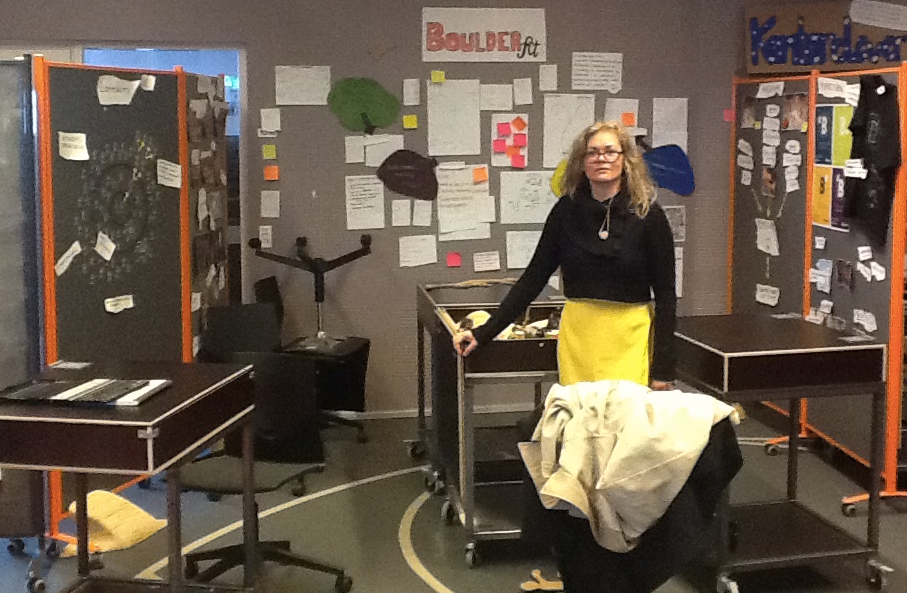
Photo: Anete Mikkala Camille Strand, Ph.D. at the Material Storytelling Lab at Aalborg University, Denmark (Photo by D. Boje, 2014).
Dr. Strand has trained the sandplay method extensively for several years and translated it to bring together the two areas (sandplay and storytelling) in the 'material storytelling' mode ‘stories of artifacts’ and in doing so it reconfigures from a therapeutic field to a storytelling field within organizations and teaching/research. Dr. Strand works with adults. Her lab focused on helping companies resdesign and change work processes. Boje, in particular, has been working with Strand since 2009, and served on her dissertation committee (Boje, Jørgensen, & Strand, 2013). Dr. Strand is a frequent presenter at the annual conferences devoted to storytelling research (Standing Conference for Management and Orgnaizaitonal Inquiry sc'MOI, and Quantum Storytelling Conference in New Mexico.
Strand, Anete Mikkala Camille (2012) Enacting the Between - On dis/continuous becoming of/through an Apparatus of Material Storytelling.(More on Material Storytelling Lab). Download summary in English
Download summary in Danish
Download PhD thesis: Book 1 /// Book 2Boje, David; Jørgensen, Kenneth Mølbjerg; Strand, Anete Mikkala Camille (2013). Towards a postcolonial storytelling theory of management and organization. Journal of Management Philosophy. Vol 12 (1) 43-66.
"The Material Story Lab offers a process-oriented and holistic approach to practices of knowing and becoming" (Material Storytelling Lab, Denmark). It is our intention to work closely with Dr. Stand to develop a storytelling lab here in New Mexico.
How ERP works? We begin in Step 1 with stories of the veteran at their best to set a baseline of authentic Self identity. Then in Step 2, we Externalize and name the problem as the problem, externalizing it from the person. For example, we name ‘Mr Stress’ or (Spirit of Stress) as the problem that has gripped the veteran. In steps 3 and 4, it is important to deconstruct the ways society, medical establishment, the media (movies, TV, news), and even the military are characterizing, making the person into a pathology, simulacra, a stigma, a stereotype. When a person is pathologized, they become the problem to be fixed by meds or treatments, or just shunned. Step 5, reclaims those Little Wow Moments of exceptoin to the grand old story of the Sad Sak veteran, who has internalized a permanent pathology from media, or traditional treatment modes.
Table 1: 7 STEPS of Embodied Restorying Process with ♥ of Care |
1. Recharacterize (authentic Self identity) |
2. Externalize (de-label the Disorder Label) Make the Problem the old story, not the person. |
3. Sympathize (benefits) – of old story; Map the payoffs |
4. Revise (consequences) – Map the Organization & Economic influences of old story/old stereotypes |
5. Strategize (Little Wow Moments of exception to grand old story) |
6. Restory (rehistoricizes the Grand old Story by collecting Little Wow moments into New story) |
7. Publicize (support networking) e.g. letter writing with supporters of your ‘New Story’ |
Step 6 completes the restorying process. It rehistoricizes the Grand old Story of Sad Sack, by collectiong the Little Wow moments of exception and success events into a New story.
Step 7 is important. The family and friends form a support system for the veteran to sustain the New story. This can be done by face-to-face meeting or by letter writing between the veteran and the family and friends. Below we introduce a way to do this process and strengthen New Story efficacy during deployment.
In sum, the ERP anchors the New Story in embodied life of the veteran's family support system. It does this by using material objects, in sand play, and in the equine-assisted growth and learning events (EAGLE), in the bigger sandplay with live horses and live people, and material objects, as Service Members and Family members tell and retell, and restory their deployment experiences, and attain more self-efficacy, and self-agency to author their own story, while learning to resist and refust the Grand Narratives such as stigma and stereotype. In each military context there are many Grand Narratives (Lyotard 1979/1984) that privilege one standpoint over any others (e.g. Macho Warrior who refuses mental health care). And each Grand Narrative has an ideology that marginalizes others' ideologies, and discounts the living story web of relations that Service Members and Family members have with one another. More one difference of Grand Narrative and Living Story Web.
Lyotard, Jean-Francois. (1979/1984). The Postmodern Condition: A Report on Knowledge , (Vol. 10). University of Minnesota Press. (1979 in French’ 1984 English translation).
Rosile, Grace Ann. (2007). Managing with Ahimsa and Horse Sense” A Convergence of Body, Mind, and Spirit. Pp. 175-180 in Jerry Biberman and Michael D. Whitty (Eds.) At Work: Spirituality Matters. Scranton/London: University of Scranton Press.
Rosile, Grace Ann & David M. Boje. 2002. Restorying and postmodern organization theatre: Consultation in the storytelling organization. Chapter 15, pp. 271-290 in Ronald R. Sims (Ed.) Changing the Way We Manage Change. Wesport, CONN/London: Quorum Books. Click here for pre-press PDF
We have found it very effective to precede ERP sessions with Equine-Assisted Growth and Learning (EGALA) events. The reason is many Service Members have learned to avoid stigma and stay closed off, withdrawn, and not seek help.
1. Equine-Assisted Growth and Learning (EGALA) for Veterans and their Family Members
The Horse is a Mirror of Service Member and Family members' emotional well-being. The horse is the most excellent story-listener to Service Members. Horses are attuned to body language, and to human's emotions and stress levels. Why? Horses are prey animals, on the alert to any predators, and stressors, any signs of change in emotion. At the same time horses are herd animals, and take care when then see someone pained around them.
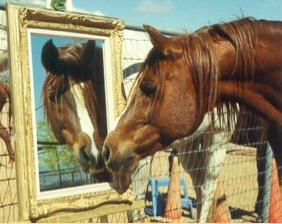

Our research uses EAGALA ethical standards and practices for working with Service Members and Family members. Dr. Boje and Dr. Rosile are certified in EAGALA Military Services, a designation which indicates the EAGALA Model certified professionals have specialized training and experience in the military community. More
- Read selected articles on EAGALA horse therapy with military
- Watch video on EAGALA Military Services programs
- Read an example of a sample EAGALA session with military
- Introduction to providing EAGALA with the Military
Dr. Rosile uses equine-assisted growth and learning events (EAGLE) to develop leadership, build teams, and improve problem-solving skills. One way to think about EAGLE is that the area is a huge sandtray in which Service Members and Family members can tell their story, silently, without words. It is storytelling and story-listening using human and horse bodies, and material objects (rails, cones, and so on).
Horse Sense At Work.mov
"Horse Sense At Work" is an educational film outlining Leadership, Teamwork and Communication techniques demonstrated with the use of horses. Written by Dr. Grace Ann Rosile. Las Cruces, New Mexico at Dunn Ranch.
This next video is a concise statement of why equine-assisted interventions are particularly effective with veterans. Keep in mind that without Random Control Trials (RCTs), there is no way to assess the scientific merit of the antecdotal claims.
Horses that Heal, Veterans - Equine Nonprofit Network NC
Horses that Heal is a 501c3 in Linden, NC that uses horses to help people reach goals. They have an equine assisted ...
In the next video, you can see that Equine qork is widely used by the military across the United States.
How Horses Help an Army Veteran Heal from PTSD - In Deep Shift - Oprah Winfrey Network
Brian Mancini is an Army veteran who battles post-traumatic stress disorder after having served in Baghdad.
The next video is how veterans from Fort Jackson maje use of equine-assisted growtha and learning events, in the EGALA model. However, onece again, we stress there is only non-control, non-random, no trails research results on this. We clearly need to develop RCTs to measure the efficacy outcomes.
Learn how wounded warriors are using horses to help improve their lives.
Combining EAGLE with ERP
Our second intervention, can be combined with EAGLE (Equine-Assisted Growth Learning Events). We have found it helps to start veterans and their family members with EAGLE then bring in the ERP (Embodied Restorying Process). The reason is veterans often jsut do not want to talk about deployment experiences. The EAGLE approch allows them to focus on the horses, and act it out with family members. Then, they we can follow up with ERP, letting the Service Member and family members tell their deployment story without words, using material objects (Strand, 2012).
Boje is affiliated with an Honory Doctorate from Aalborg University (Denmark (and the Material Storytelling Lab (see Boje, Jørgensen, & Strand, 2013 for more on this topic). Boje and Liz EnglandKennedy of New Mexico State University have developed a portable version of material apparatus to work with Veterans and their Family members, that builds on White and Epston's (1990) text-based restorying, and moves beyond it using 'material apparatus' of sandlay as pioneersed by Dr Strand (2012). The contribution of Dr. Boje and Dr. EnglandKennedy is to use repeated rounds of restorying during the sandplay with former Service Members of the Military, and with Student-Veterans in-order-to generate more self-efficacy, self-agency, and self-authoring storytelling results.
2. Embodied Restorying Process (ERP) with Sandplay
We are using a temporary STORYTELLING LAB at NMSU to work out the methodology

We use a portable STORYTELLING LAB with Community of Hope Veterans to perfect our Embodied Restorying Process (ERP). Above is a demonstration of the ERP at the Teaching Academy event at New Mexico State University held 27 August, 2014 in Milton Hall, Room 50 (converted to a temporary lab).
Instead of text-based approach to restorying (White & Epston, 1990), Boje and EnglandKennedy, focus is what Brandt and Clinton (2002: 344), refer to as a Latourian approach, “the “capacity to be visible and animate outside the interactions of immediate literacy events. These capacities stem from the legibility and durability of literacy: its material moors, its technological apparatus, its objectivity, that is, its (some)thing-ness.” This is a departure of storytelling form word- and text-contexts, to how people and things “are given the status of social actors” (IBID.: p. 348). ERP incorporates “materiality, its (some)thingness” into the storytelling, story listening, and story noticing processes (p. 353). The material dimensions of storytelling (Strand, 2012) hold together multiple agents (material inanimate things, and in EAGLE the live horses and people).
More on this topic: Material storytelling in organization and systems design, SEE STUDY GUIDE NEW MATERIALISMS
Here is a short video by Dr. Boje and Dr. EnglandKennedy, on how ERP is combined with Dr. Strand's material-sandplay-for-adults, in-order-to do repeated rounds or restorying with formerly homeless veterans at Community of Hope in Las Cruces New Mexico.
Embodied Storytelling Healing for Veterans by David Boje and Liz EnglandKennedy.
Work by Boje (international storytelling and restorying researcher) and EnglandKennedy (2013, video), a Mediacal Anthropologist and Social Worker, with the formerly homeless veterans at Community of Hope in Las Cruces New Mexico developed the Embodied Restorying Process (ERP). It is not the usual or traditional sandplay that is based on Jungian psychology. In Jungian sandplay, the therapist is the expert, and interprets the display of material objects.
Again, we remind the reader: the problem with these and other interventions to help Service Members and their Families is that there is a lack of rigorous research using Random-Control-Trials (RCTs) that follow up to prove the efficacy of the interventions.
We intend to find major funding, to expand these pilot study results, to do RCTs that will prove, one way or the other, the efficacy of EAGLE and ERP interventions.
3. Our Research Projects
PT140076 Pre-Proposal: Evaluation Study of Equine and Restorying Treatment Trials for Post-Deployment Veterans and their Families; PT140076 Partnering PI Professor Hans Hansen – Texas Tech University, Lubbock
See DoD Grant Psychological Health/Traumatic Brain Injury Research Program is a four year grant for 1.5 million dollars.
Status: Proposed to DoD. Awaiting decision.
Focus Area: Interdisciplinary and comprehensive prevention and life-skills training strategies to improve brain health.
Research Design: Projected Quarterly Enrollment
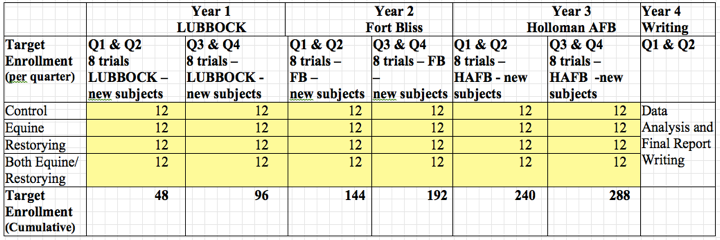
Abbreviations: NMSU (New Mexico State University; LUBBOCK (Lubbock Army Nat'l Guard in Lubbock, TX); FB (Fort Bliss in El Paso TX); HAFB (Holloman AFB in New Mexico).
Summary: Each two quarters 12 Service Members & Families assigned to conditions: Control, Equine, & Restorying; In First two quarters the control (wait-list) are recruited for quarters 3 and 4 & 12 new control (wait-list) so, by the end everyone has opportunity for 8 trials of Equine, Restorying, or Both treatments. 8 trials repeated with different subject samples twice in LUBBOCK, FB, and HAFB: total of 48 trails, in all.
Overall Design: 72 Service Members & Families in control group; 72 in Equine treatment; 72 in Restorying; 72 Both Equine & Restorying; 96 Service Members and Families at LUBBOCK; 96 at FB; 96 at HAFB; Total of 288 Service Members, 288 Spouse/Partner; approximately 400 children between 8 and 18; Grand Total 976 individuals across the three years
Our RCTs proposal allows us to expand \ increase sample size to allow more robust statistical tests can go beyond single case approach, i.e. study by Palgi and Ben-Ezra (2010) using oral narrative restorying
Palgi, Yuval, and Menachem Ben-Ezra. (2010). "" Back to the Future": Narrative Treatment for Post-Traumatic, Acute Stress Disorder in the Case of Paramedic Mr. G." Pragmatic Case Studies in Psychotherapy 6.1 (2010): 1-26. http://www2.scc.rutgers.edu/journals/index.php/pcsp/article/viewFile/1012/2406
Hypotheses and Military Relevance
- Hypothesis 1: Equine & Restorying training encourage higher rates of training participation/completion by working with Families, not just Service Members
- Hypothesis 2: Faster reintegration of Service Member and Family after deployment
•Rationale: RCTs will allow more robust statistical tests and qualitative measures to prove or disprove efficacy of EGALA and ERP conditions.
•Military Relevance: Focus on military families can improve access to Service members who are hypothesized to come into treatment and stay in, at higher rates than without family members
NIH Systems Science and Health in the Behavioral and Social Sciences (R21)2 Year (R21) – Professors Meghan Downes and David Boje College of Business (Letter writers) http://grants.nih.gov/grants/guide/pa-files/PAR-11-315.html
For example, Story maps use geography as a means of organizing and presenting information. They tell the story of a place, event, issue, trend, or pattern in a geographic context.The Story maps support visualization, queries, analytics, and pop-ups for map features with rich content including photos and graphs.Map-based storytelling is fun, compelling, and helps us all better understand our world.
- Story Map Tour℠ This app presents a sequential, place-based narrative in the form of a series of geotagged photos and captions linked to an interactive map. Learn More
- Story Map Journal℠ This app lets you create a compelling map-based narrative presented as a set of journal entries. It's ideal for creating multimedia stories that combine text, maps, images, and video, especially when you have lots of text or a rich array of content. Learn More
-
Story Map Shortlist℠ This app lets you present a set of places organized into a set of tabs based on themes, for example, cities, duty stations, etc. As users navigate around the map, the tabs update to show them the places in the current map extent. Learn More
4. Develop an App based on Military Members and Family Members Deployment situation. We want to work with Material Storytelling Lab of Denmark, and Taylor Burgett
CEO, Byteware in New Mexico and Meghan Downes, Ph.D. a Agent-Based Modelling expert to develop acommunication 'App.' Boje is going their in October, 2014, and has visited the lab several times before. Working with Anete Camille Strand (2012), our team can show, through Agent-Based Modeling studies, the specific rhizomic pattern (entangled genealogy) for all the projects... and for all the story labs that are popping up here and there centered on using artifacts and sandboxes. This follows the FAB-lab movement at MIT. (More on this).
Besides DoD, we are applying to grants to do two-year project for National Institute of Health (NIH) funding.
ADDITIONAL PROJECT ONE FUNDING WITH NIH: Oct 16 deadline for submitting full proposal– NIH Research on Children in Military Families: The Impact of Parental Military Deployment and Reintegration on Child and Family Functioning (R21)– Dr. Liz EnglandKennedy HSS (Lead grant writer)http://grants1.nih.gov/grants/guide/pa-files/PA-11-202.html
The focus is on a two year study of Reintegration of Child and Family Functioning.
Alo House, combined experience and expertise working with those who suffer from addiction, from the initial ‘crisis intervention,’ all the way through the inpatient and outpatient treatment levels of care, to aftercare and alumni services. We provide 'evidence-based' drug and alcohol treatment that really works, including life-skills building, and experiential, effective guidance in creating and maintaining healthy and lasting recovery.
Thank you for your time. We seek a letter of support to pursue federal funding (DoD and NIH) to do the RCTs on larger samples, in-order-to develop the level of statistical power, to prove the eficacy of equine-assisted and embodied restorying treatment approaches.




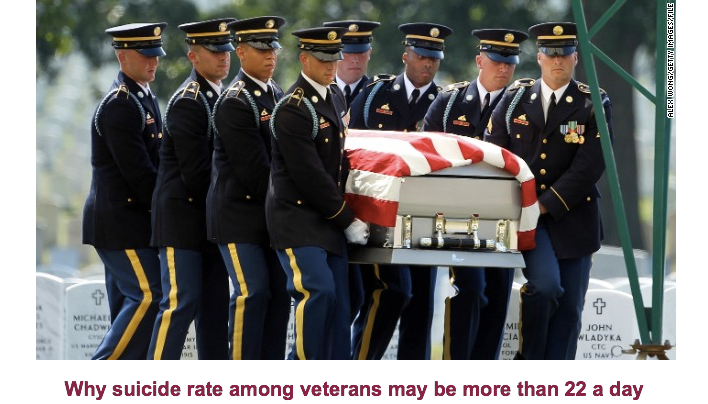




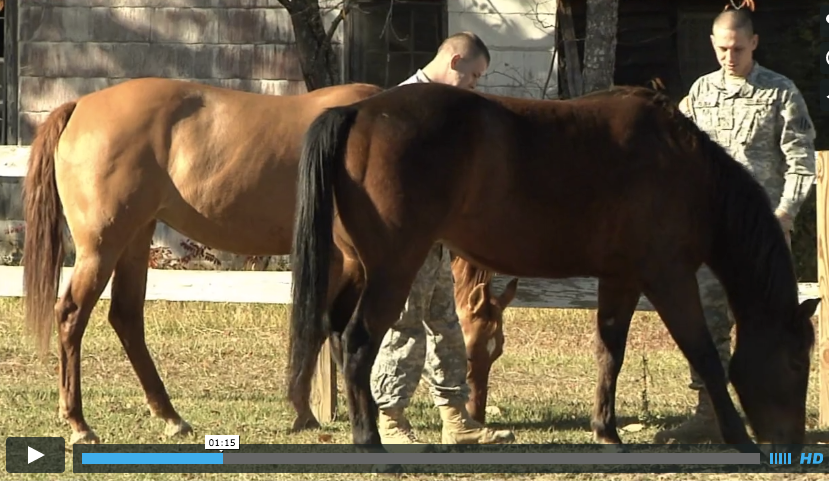

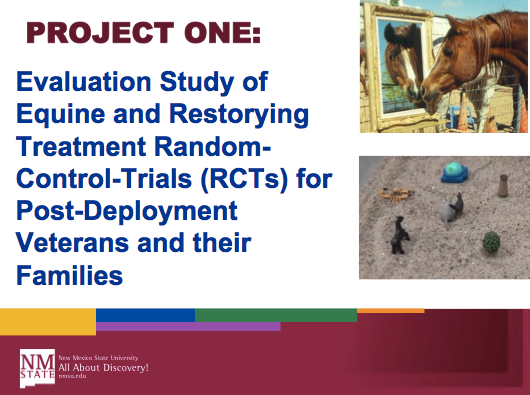
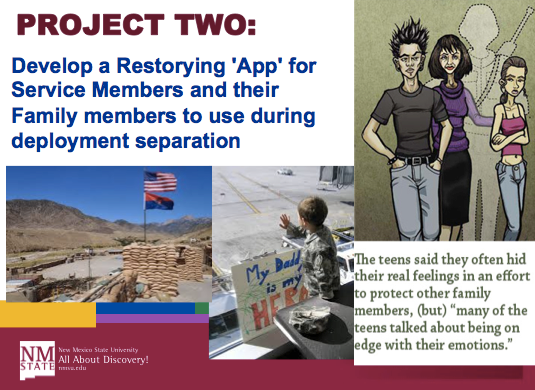

 EAGLE
EAGLE